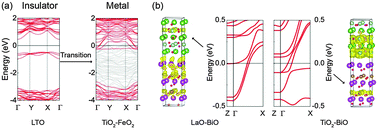Prediction of a metal–insulator transition and a two-dimensional electron gas in orthoferrite LaTiO3/tetragonal BiFeO3 heterostructures†
Abstract
Using first-principles calculations, we investigate the electronic and magnetic properties of orthoferrite LaTiO3/tetragonal BiFeO3 superlattices with different terminations. The interfacial electronic reconstruction along with formed chemical bonds transforms LaTiO3 into a metal by means of the Anderson and Mott transition. In particular, a two-dimensional electron gas appears at interfacial regions located in LaTiO3 of model LaO–BiO and BiFeO3 of model TiO2–BiO due to the d–p, d–d electron interactions and ferroelectric polarization. Moreover, the Fe and Ti magnetic moments are sensitive to the interfacial geometry and hybridization, and a 19% spin polarization of LaTiO3 is gained in model TiO2–FeO2. Our results demonstrate that the interfacial geometry and hybridization can successfully tune the Fermi energy and the Hubbard band of LaTiO3, and novel physical properties in different models provide opportunities for developing functional nanoelectronic devices.


 Please wait while we load your content...
Please wait while we load your content...